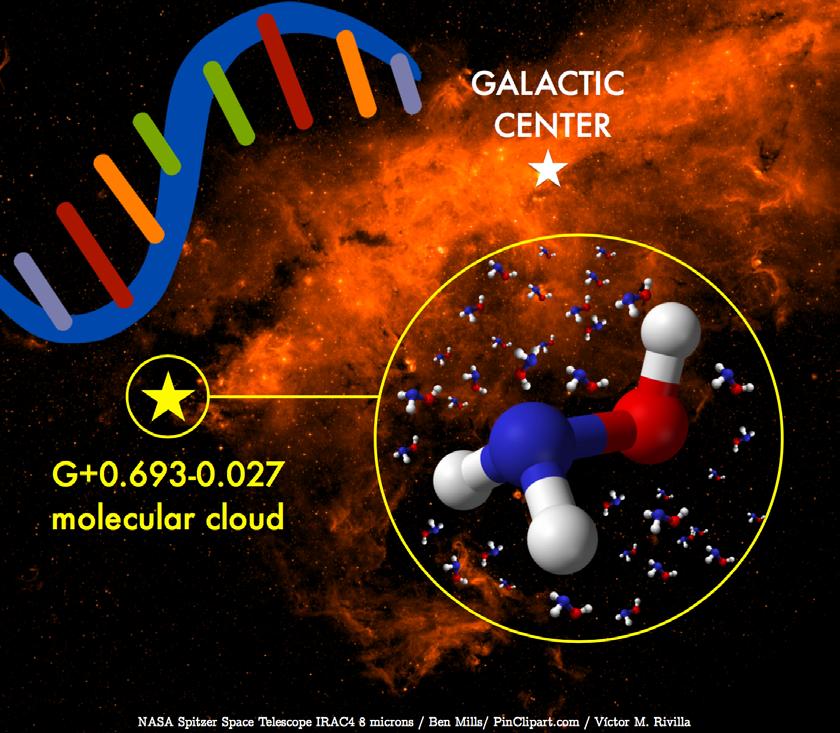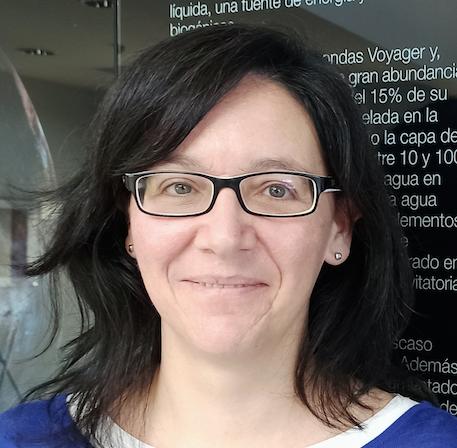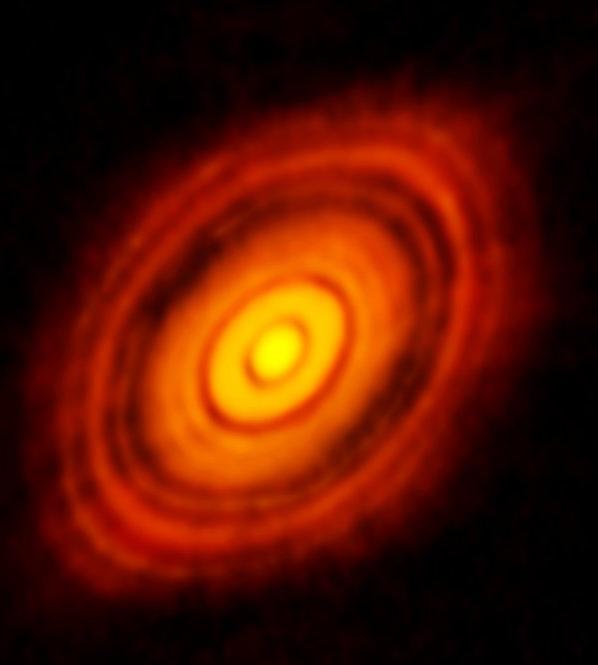
8 minute read
Let's talk about... the origins of life
from Contact 06
The apparent detection of phosphine in the clouds of Venus made headlines around the world in September. While the result is proving contentious among scientists, it turned the spotlight onto astrobiology, the study of how, when, and under what conditions life may form in the Universe.
In astronomy, observing how other worlds form and how life may emerge on them is part of ‘Cradle of Life’ studies, a field that spans many specialisms. Our brief expedition into this broad topic focuses on two aspects: planet formation and the search for the building blocks of life. Let’s start with those building blocks.
Dr Izaskun Jimenez-Serra, Centre for Astrobiology, Spain
“Carl Sagan once said: ‘We are all made of stardust.’ And he was right,” says Dr Izaskun Jimenez-Serra of Spain’s Centre for Astrobiology, an expert in astrochemistry and former chair of the SKA’s Cradle of Life Science Working Group. “Not only do the atoms that form our body come from old stars; we currently believe that some organic compounds key for the metabolism and biochemical processes in living organisms could also have come from outer space, because they are known to form in interstellar space and they have been found in meteorites.”
We’re talking here about detecting molecules in space. Molecules are made of atoms – oxygen has two (O2), water has three (H2O). What astronomers look for are “complex organic molecules” (COMs), carbon-based compounds made of at least six atoms, such as methanol (CH3OH). COMs are exciting for astronomers because they could, given the right set of conditions, lead to life forming.
“Contrary to what people might think, these molecules are ubiquitous in the Universe and can be found in many different astronomical objects, ranging from the coldest regions of the interstellar medium [the dust and gas that fills the spaces between stars], to the dusty and dense cocoons of protostars, to harsh environments such as the centre of our galaxy,” says Izaskun. “COMs have been detected even in distant galaxies as far as seven billion light years away from us. This is exciting because it tells us that chemistry, and in particular complex organic chemistry, starts early on in the Universe.”

The complex organic molecule hydroxylamine (NH2OH, in the image) and urea (NH2CONH2) were among those recently detected in the interstellar medium. These prebiotic molecules could have been part of the process that led to life on Earth within theories of a primordial RNA-world.
Credit: Nasa Spitzer Space Telescope, camera IRAC4 (8 micron) / Ben Mills / PinClipart.com / Víctor M. Rivilla
Some of these COMs are “prebiotic” – precursors to those which may have led to life. Among them are the molecular precursors to RNA, a similar molecule to the well-known DNA (which carries the genetic information of every living organism). In fact, here on Earth some viruses, including COVID-19, replicate through RNA.
One theory which emerged in the 1960s (and is still being debated) sees RNA as the driving force behind the beginnings of life on Earth millions of years ago. It’s thought these prebiotic molecules could have become incorporated into comets and meteorites which intensively struck the Earth around four billion years ago, Izaskun says.

Dr Izaskun Jimenez-Serra
Credit: Izaskun Jimenez-Serra
Of course, molecules are tiny, and most of the regions where we study them are thousands of light years away. Luckily, the natural emission from COMs in the cold reaches of outer space is of low energy, placing them in the radio band of the electromagnetic spectrum, making radio telescopes uniquely placed to detect them.
“Every molecule has its own unique fingerprint, made up of a collection of signals at different wavelengths - this is caused by molecules being excited into different energy levels, and in the cold regions it’s caused by the molecules rotating. Radio telescopes can search all these wavelengths, a bit like an old analogue radio searching for different channels. If all the wavelengths from a given molecule can be found, then the molecule is definitely present in space,” Izaskun explains.
Because they are made of more atoms, COMs are larger than simple molecules so they rotate slower, resulting in centimetre wavelengths, which lie within the frequency ranges covered by the SKA.
“The SKA also has the potential to become a great COM detector because, for astrochemists, centimetre wavelengths are much ‘cleaner’ than millimetre wavelengths, which tend to be crowded with these smaller, simpler molecules. This, together with the high sensitivity of the SKA, will help us to identify new prebiotic molecules in space - molecules which have never been detected before beyond Earth.”
Finding the molecules is one thing, but for life to eventually form requires a habitable home. That’s why understanding planet formation is crucial to Cradle of Life studies.
And before a planet, must come a star. As a star forms, a collection of dust and gas debris is left swirling around it, creating a protoplanetary disk. There’s still a lot that we don’t know about the process, but it’s believed that these microscopic dust particles stick together, a bit like how a snowball becomes larger and larger, except in this case over the course of a few million years.
Radio telescopes can watch the process unfold by detecting the signals emitted by these dust grains; smaller grains emit shorter wavelengths, and larger grains emit longer wavelengths, making this a great example of multiwavelength astronomy and the complementarity of different telescopes.
The Atacama Large Millimetre/submillimetre Array (ALMA) in Chile has made huge advances in this field in recent years by observing millimetre-sized dust grains as they begin to coalesce. ALMA has been able to pinpoint for the first time a location where a young planet is being born, provided high-resolution images of disks to identify commonalities and differences between them, and in 2014 released a stunning image of the disk around a young star which turned existing thinking on its head.

ALMA’s high-resolution image of the protoplanetary disk surrounding the young star HL Tauri, released in 2014. It revealed previously unseen substructures in the disk, and gaps which could be the result of planets forming.
Credit: ALMA (ESO/NAOJ/ NRAO)
The detailed image of the disk around HL Tauri, a million-year-old star (a relative baby in star terms), suggested the early stages of planet formation were already under way. Until then, it was thought the process was much slower, so wouldn’t be visible in such young star systems.
While ALMA deals with millimetre wavelengths, the SKA will step in to fill the current gap in our knowledge of the next step in the process, observing larger pebbles in the disk. A recent paper, co-authored by members of the SKA Cradle of Life Science Working Group, showed that it will also make a clearer picture of the rings that newly forming planets carve in protoplanetary disks, like an ice-breaker clearing a path through the sea.
“With the SKA it will be uniquely possible to witness this phase of planet assembly by observing at exactly those radio wavelengths that match the size of coalescing particles, from centimetre scales to metres; and with sufficient resolution to watch the growth of planets in the habitable zone around their parent stars,” says Dr Tyler Bourke, SKA Project Scientist and a co-author on the paper.
“ALMA has revealed amazing structure in disks but is not sensitive to objects bigger than dust; the longer wavelengths observed by SKA are needed to detect pebbles, which will reveal the birth-sites of exoplanets. This will also give us more clues about how our own Solar System formed.”
DID YOU KNOW?
Even here on Earth some organisms – known as extremophiles – can flourish in environments humans would consider extreme, without oxygen, under extremely high pressure, buried in the ice or under intense heat. One of the best known is the tardigrade, which can survive temperatures from -200 to 150°C, being deprived of water and oxygen, pressure six times greater than the deepest ocean, and a host of other discomforts.
Since the discovery of the first exoplanet orbiting a Sun-like star in 1995 (for which Prof. Michel Mayor and Prof. Didier Queloz were awarded the 2019 Nobel Prize for Physics), studies have focused on their potential habitability, based on whether a planet lies in a zone where water can exist in liquid form. Part of the surprise surrounding the Venus phosphine announcement was that, on Earth, phosphine is associated with biological processes, but Venus is considered inhospitable in the extreme: intensely hot, smothered by an atmosphere of mainly carbon dioxide and with clouds of sulphuric acid thrown in for good measure. If life were to be found there, it would radically change our definition of hospitable, and of where life can emerge, but further studies will be required to test and understand the results before making that jump. The team behind the results have themselves downplayed them since, due to questions over the data processing methods used.
Irrespective of what’s happening on Venus, the Universe holds many more secrets on the origins of life, and the SKA is ideally placed to reveal them.
Dr Tyler Bourke, SKA Project Scientist
“The formation of planets and the viability of complex, prebiotic molecules, during their formation are two exciting areas where observations at centimetre wavelengths with the SKA will be crucial for significant advances in our understanding,” Tyler adds. “Locating the formation sites of future planets, and understanding the evolution of complex molecules in these environments, are key to understanding how Earth formed, and the likelihood of life arising on other planets.”
By Cassandra Cavallaro (SKAO)
Further reading:
Observing protoplanetary discs with the Square Kilometre Array - https://arxiv.org/pdf/2009.00562.pdf
Prebiotic precursors of the primordial RNA world in space: Detection of NH2OH - https://arxiv.org/pdf/2008.00228.pdf










